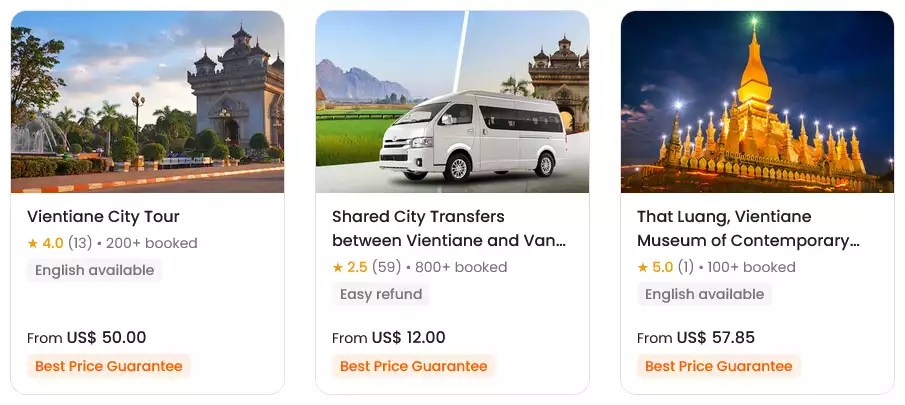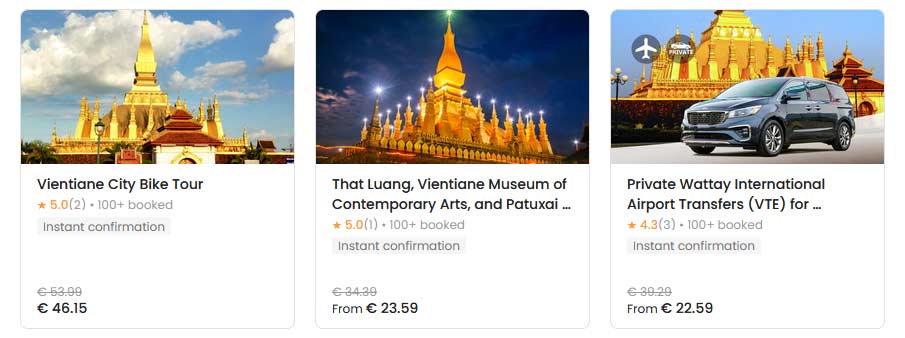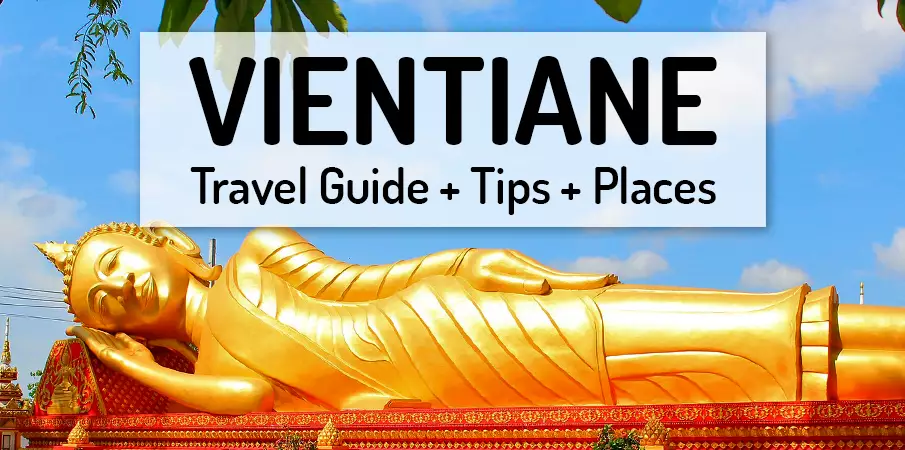
ℹ️ Information – Vientiane
✈️ How to get to Vientiane
☀️ Weather in Vientiane
🏡 Where to Accommodate
🔍 Sightseeing in Vientiane
❓ FAQ + Travel Tips + Info
🎫 Book a Tour in Vientiane
🎫 Book Ticket to Vientiane
Quick answer: Vientiane, the laid‑back capital of Laos, blends rich history with a relaxed riverside charm. You’ll find golden stupas, colonial-era architecture, and a peaceful Mekong promenade — perfect for slow exploration, cultural immersion, and heartfelt conversations over Lao food.
At a glance:
- 🕌 Temples & Landmarks: Iconic sites include Pha That Luang, Wat Si Saket, and Patuxai (Victory Monument).
- 🌿 Buddha Park: A sculpture garden just outside the city with quirky, giant statues.
- 🛍️ Markets: Wander through Talat Sao Market for textiles and the riverside Night Market for local crafts.
- 🏛️ Museums & History: Visit the Lao National Museum and the COPE Visitor Centre to learn about Laos’ past and its resilience.
- 🚶 Riverside Vibes: Stroll along the Mekong promenade for stunning sunset views and relaxed café moments.
- 🍽️ Food: Try Lao specialties like larb, tam mak hoong, sticky rice, and enjoy French-influenced pastries.
- 🏰 Colonial Architecture: The city’s French legacy is visible in buildings like the Presidential Palace and Patuxai.
- 🕰️ Best Time to Visit: November–February offers cooler, dry weather — ideal for walking and exploring.
Last updated in November 2025
Vientiane: Where Tradition Meets Tranquility on the Mekong.
-
- Vientiane is the capital and largest city of Laos, a landlocked country located in Southeast Asia. It is situated on the banks of the Mekong River, which forms the border between Laos and Thailand. Vientiane is positioned in the northern part of Laos, near the country’s border with Thailand.
- Geographically, Vientiane is located at approximately 17.97 degrees latitude and 102.61 degrees longitude. It covers an area of around 3,920 square kilometers (1,510 square miles). The city lies in a relatively flat region, with the Mekong River flowing along its western side.
- Vientiane’s location along the Mekong River has played a significant role in its history and development. The river serves as an important transportation route, connecting Vientiane to other parts of Laos as well as neighboring countries. Additionally, the fertile floodplains along the riverbanks have supported agriculture and provided resources for the city.
- The city’s strategic location near the Thai border has also influenced its development. Vientiane has served as a major trade and commercial hub between Laos and Thailand, fostering economic activities and cross-border exchanges. In terms of neighboring regions, Vientiane is bordered by several provinces of Laos, including Vientiane Province to the east and south, as well as Xayabury Province to the north. Across the Mekong River to the west lies the Nong Khai Province of Thailand, with the Thai city of Nong Khai being the closest major urban center.
- Overall, Vientiane’s geography and location have shaped its history, economy, and cultural exchanges. The city’s position on the Mekong River and its proximity to the Thai border have contributed to its status as the political, economic, and cultural center of Laos.
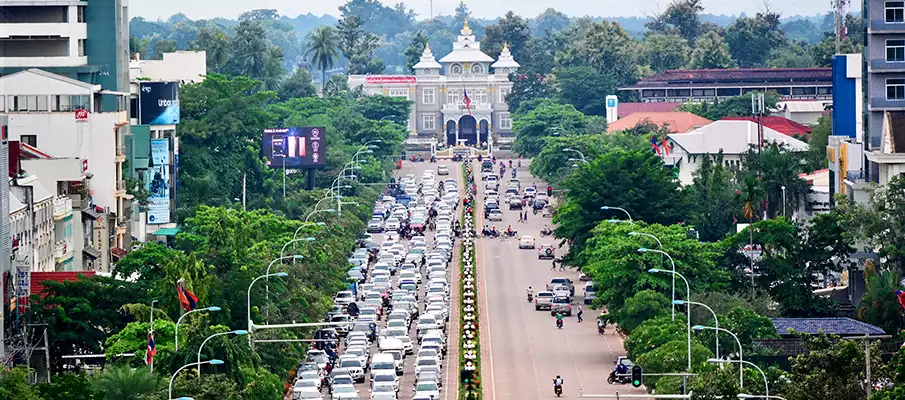
Vientiane: A Journey through the Rich History of Laos.
-
- Vientiane, the capital city of Laos, is a place where history comes alive, weaving a captivating tapestry that reflects the country’s cultural heritage. With a legacy spanning centuries, Vientiane’s history is as vibrant as the city itself.
- Originating in the 9th century as a bustling trading hub along the Mekong River, Vientiane flourished as the capital of the Kingdom of Lan Xang. Under the reign of King Setthathirat in the 16th century, it reached its zenith, becoming an important center of power and culture. Temples and palaces were built, and the city thrived as a beacon of Buddhism and the arts.
- Throughout its history, Vientiane faced periods of Siamese (Thai) influence, enduring sieges and the destruction of its temples and landmarks. The city’s fortune shifted with the arrival of the French in the late 19th century, as it became part of French Indochina. The French influence is evident in the city’s architecture, with charming colonial buildings that grace the streets, blending European styles with local aesthetics.
- With Laos gaining independence in 1953, Vientiane became the capital of the newly formed Kingdom of Laos. However, it also bore witness to the turbulent times of the Vietnam War, serving as a base for the United States and suffering from bombings that scarred its landscape. The war’s aftermath led Laos to experience political changes, transitioning to a socialist government.
- In recent years, Vientiane has dedicated efforts to preserving its cultural heritage. Restoration projects have revived the city’s historical sites, including the revered Pha That Luang, a symbol of Laos‘ spiritual and national identity. The city’s temples, such as Wat Sisaket and Wat Si Muang, proudly showcase their intricate architectural designs and serve as revered places of worship.
BOOK a TOUR / TRIP in Vientiane ➜
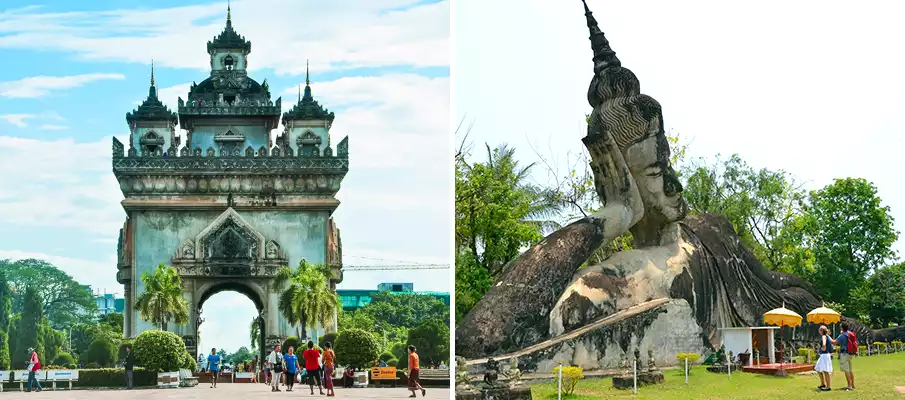
Vientiane’s culture reflects the rich heritage of Laos.
The culture of Vientiane, the capital city of Laos, is deeply rooted in Lao traditions and Buddhist influences. Here are a few key aspects of Vientiane’s culture:
-
- Buddhism: Buddhism plays a significant role in the daily lives of people in Vientiane. Temples, or wats, are scattered throughout the city, and residents often participate in religious rituals, including offering alms to monks and visiting temples for prayer and meditation.
- Traditional Festivals: Vientiane celebrates various traditional festivals that highlight Lao culture. One of the most important festivals is Boun That Luang, held at the famous That Luang Stupa. During this festival, locals engage in religious ceremonies, processions, and vibrant parades.
- Architecture: Vientiane showcases a blend of traditional Lao architecture and colonial influences. The city features ornate temples with intricate designs, such as the iconic Pha That Luang, as well as French colonial buildings from the colonial era.
- Cuisine: Lao cuisine is renowned for its flavors and unique dishes. Vientiane offers a wide array of local culinary delights, including dishes like sticky rice, larb (spicy minced meat salad), and tam mak hoong (spicy green papaya salad). Food markets and street stalls are popular places to explore the local food scene.
- Traditional Arts and Crafts: Vientiane is known for its traditional arts and crafts, including intricate silk weaving, wood carving, and silverware production. Visitors can explore local markets and artisan workshops to witness these traditional crafts being created.
- Traditional Music and Dance: Lao traditional music, often accompanied by the khene (a traditional wind instrument), is an integral part of cultural performances in Vientiane. Classical Lao dance, with its graceful movements and colorful costumes, is also showcased during festivals and cultural events.
- Friendliness and Hospitality: The people of Vientiane are known for their warm hospitality and friendly nature. Visitors to the city often experience a welcoming and relaxed atmosphere, making it a pleasant destination to explore and interact with the locals.

Vientiane: A Perfect Blend of History and Relaxation.
-
- Vientiane, the capital city of Laos, is a captivating destination that seamlessly combines rich cultural heritage with a laid-back atmosphere. This charming city offers a plethora of historical and cultural sites to explore. From the glistening Pha That Luang, a symbol of national pride, to the serene temples like Wat Si Saket, visitors can immerse themselves in the spirituality and architectural marvels of Vientiane.
- The riverside promenade, stretching along the Mekong River, invites tourists to take leisurely strolls while enjoying breathtaking views. Parks like Chao Anouvong and Buddha Park provide serene escapes within the city, featuring captivating statues and lush green spaces.
- Vientiane’s architectural landscape reflects its French colonial past, with notable landmarks like the Presidential Palace and the Lao National Museum. The city’s cafes and restaurants serve a delectable fusion of Lao and international cuisines, enticing visitors with flavors unique to the region.
- Immersing in the local culture, tourists can witness vibrant festivals such as Boun That Luang, where traditional rituals and colorful processions captivate the senses. Moreover, Vientiane serves as a gateway to explore nearby attractions like Vang Vieng’s enchanting caves or the UNESCO World Heritage Site of Luang Prabang.
- Whether indulging in traditional Lao cuisine, meandering through bustling markets, or simply embracing the city’s laid-back vibe, Vientiane offers an authentic and unforgettable experience. This hidden gem of Southeast Asia invites travelers to uncover its treasures, where history, relaxation, and cultural immersion await at every turn.
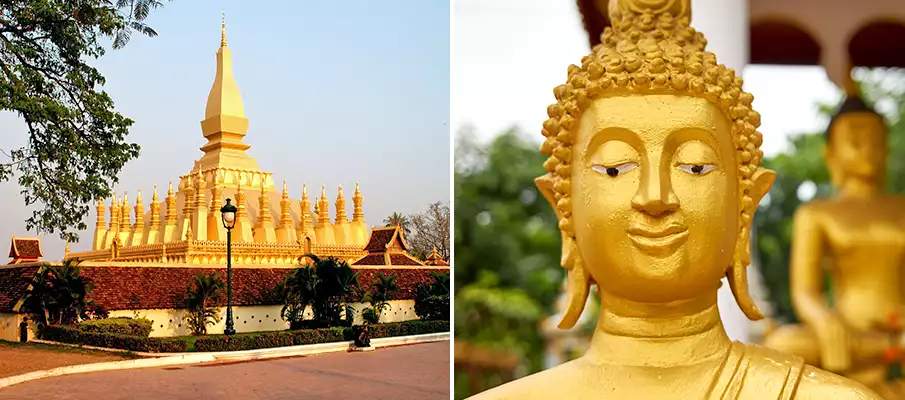
Vientiane’s Most Important Historical Temples and Buildings:
Vientiane is a place where rich history and culture seamlessly blend with the modern world. As you wander through its streets, you’ll encounter a plethora of historical temples and buildings that offer a glimpse into the nation’s past. In this article, we’ll introduce you to some of the most significant historical landmarks in Vientiane, each with a brief description of its historical and cultural significance.
1. Pha That Luang: Pha That Luang, also known as the „Great Stupa,“ is a national symbol of Laos and one of the most important Buddhist stupas in the country. This golden monument, built in the 16th century, represents both Buddhism and Lao sovereignty. It is a center of Buddhist spirituality and an architectural masterpiece.
2. Patuxai (Victory Gate): Inspired by the Arc de Triomphe in Paris, Patuxai is a unique blend of Laotian and French architecture. The monument was constructed in the 1960s to honor those who fought for independence from French rule. Visitors can climb to the top for a panoramic view of Vientiane.
3. Wat Si Saket: Wat Si Saket is one of the oldest temples in Vientiane, dating back to the early 19th century. Its cloister walls are adorned with thousands of small Buddha images, and it features a stunning combination of Laotian and Thai architectural elements.
4. Haw Phra Kaew: Haw Phra Kaew, the former royal temple, was constructed to house the famous Emerald Buddha, which is now located in Thailand’s Grand Palace. The temple is now a museum showcasing religious art, sculptures, and artifacts.
5. Wat Si Muang: Wat Si Muang is both a temple and a shrine, believed to be the spirit guardian of Vientiane. It’s known for its unique blend of Buddhist and animistic beliefs. Locals and pilgrims come here to make offerings and seek blessings.
6. Wat Ho Phra Keo: This temple, once the royal temple of the Lao monarchy, now houses an impressive collection of Buddha images and art. It’s a serene place to explore, with beautifully landscaped gardens.
7. That Dam (The Black Stupa): That Dam, the Black Stupa, is an enigmatic structure believed to be cursed. The stupa’s origins and purpose are shrouded in mystery, making it a fascinating historical site.
8. Presidential Palace: The Presidential Palace was built during the French colonial period and was used by the colonial governors. Today, it serves as the official residence of the President of Laos. Its elegant architecture reflects the colonial past of Laos.
9. Hor Phakeo Museum: The Hor Phakeo Museum is a former royal temple converted into a museum. It houses an extensive collection of Buddhist artifacts and sculptures, showcasing the cultural heritage of Laos.
10. Lao National Museum:The Lao National Museum provides insights into the history, culture, and struggles of Laos. The museum’s exhibits cover everything from prehistoric artifacts to the country’s fight for independence.
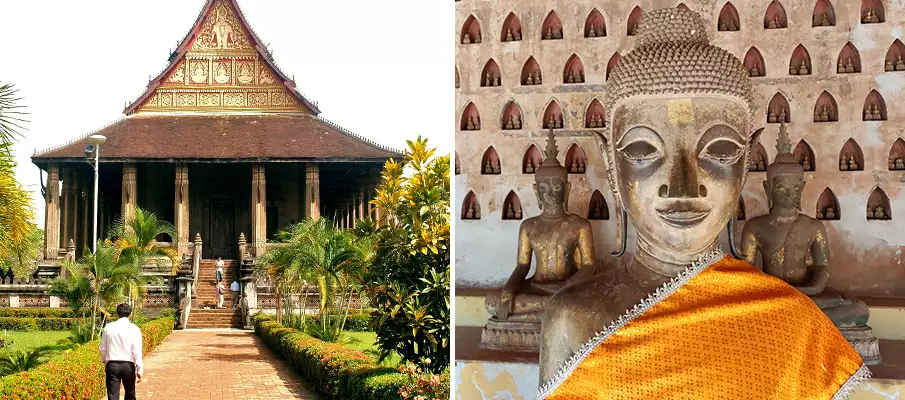
Vientiane’s Vibrant Markets: Night Market and Talat Sao Market.
Vientiane, the charming capital city of Laos, is a place where tradition and modernity seamlessly blend, and this is perfectly reflected in its bustling markets. Two must-visit markets in Vientiane are the Night Market and Talat Sao Market, offering unique shopping experiences and a glimpse into the city’s culture.
-
- Vientiane Night Market: As the sun sets over the Mekong River, Vientiane’s Night Market comes alive. Stretching along the scenic promenade, this market is a vibrant tapestry of colors, aromas, and culture. Stroll through rows of stalls displaying an array of handcrafted items, local artwork, clothing, and souvenirs. It’s the perfect place to find unique gifts and mementos of your visit to Laos.
-
- The Night Market isn’t just about shopping; it’s a sensory experience. Delight in the savory aroma of street food, listen to traditional Lao music, and watch local artisans at work. Don’t forget to test your bargaining skills; haggling is a common practice here, and it adds to the fun of the experience.
-
- Talat Sao Market: Talat Sao, or the Morning Market, is a shopaholic’s paradise. Located in the heart of the city, this multi-story mall is where you can find everything from clothing and electronics to jewelry and traditional Lao textiles. The market is known for its extensive selection of silk products, and it’s a great place to buy a custom-made traditional Lao outfit.
-
- Unlike the Night Market, Talat Sao offers a more structured shopping experience in a modern, air-conditioned setting. You’ll also find an array of local and international eateries, making it a great place to refuel during your shopping spree.

Unraveling the COPE Visitor Centre in Vientiane:
The COPE (Cooperative Orthotic and Prosthetic Enterprise) Visitor Centre in Vientiane, Laos, is a place of significance and compassion. This unique center plays a vital role in assisting those affected by unexploded ordnance (UXO) in Laos and offers valuable insights into the country’s history and humanitarian efforts.
Mission and Purpose: COPE is a non-profit organization dedicated to providing orthotic and prosthetic devices, as well as rehabilitation services, to people who have been injured or disabled due to UXO accidents. Laos remains one of the most heavily bombed countries in the world, and UXO continues to pose a threat to the local population.
Key Features of the COPE Visitor Centre:
-
- Educational Exhibits: The center houses informative displays and exhibits that shed light on the enduring impact of UXO on Laos and its people. Visitors can learn about the history of the Secret War and the ongoing efforts to clear unexploded ordnance.
- Prosthetic and Orthotic Workshops: COPE provides a unique opportunity to witness the process of creating prosthetic limbs and orthotic devices. These workshops showcase the dedication and skill of the local staff who work to improve the lives of those in need.
- Stories of Resilience: Personal stories of UXO survivors and their journeys to recovery are shared at the center. These stories are a testament to the strength and resilience of the Laotian people.
- Support and Donations: The COPE Visitor Centre allows visitors to contribute to their humanitarian mission through donations and the purchase of handicrafts made by UXO survivors.
Visiting the COPE Visitor Centre: A visit to the COPE Visitor Centre provides a deeper understanding of the impact of UXO on Laos and the ongoing efforts to assist those affected. It’s an opportunity to support a noble cause and witness the resilience and determination of the people who have overcome adversity. You can check the offical website of COPE.

Discovering Cultural Treasures: Ho Phra Keo Museum in Vientiane.
Vientiane, the capital city of Laos, is a place where history and culture intertwine seamlessly. Among its many cultural gems, the Ho Phra Keo Museum stands out as a treasure trove of artistic and religious heritage.
-
- A Historical Jewel: Originally constructed in the 16th century, Ho Phra Keo was built as a royal temple to house the revered Emerald Buddha. This precious statue was believed to bring protection and blessings to the kingdom. However, in 1779, the Emerald Buddha was taken to Thailand, where it resides to this day.
-
- From Temple to Museum: While the temple may have lost its original purpose, it has gained new significance as the Ho Phra Keo Museum. The museum houses an impressive collection of Buddhist sculptures, ancient Khmer stone carvings, and traditional Laotian religious art. These artifacts provide a glimpse into Laos‘ rich cultural and religious heritage. The temple’s architecture itself is a work of art, featuring intricate carvings and traditional Lao design elements. The serene surroundings and well-maintained grounds create a peaceful atmosphere for visitors to explore.
-
- A Cultural Experience: Visiting the Ho Phra Keo Museum is not just an opportunity to admire beautiful art; it’s a cultural experience. The museum hosts various ceremonies and rituals, offering a unique chance to witness local traditions and customs.
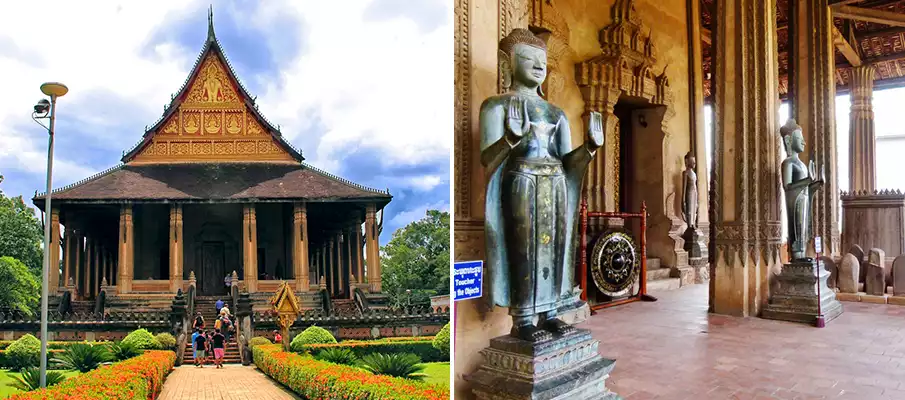
The Majestic Mekong River: Vientiane’s Lifeline and Beauty.
-
- The Mekong River, flowing gracefully along the western edge of Vientiane, holds immense importance and beauty for the capital city of Laos. This mighty river serves as a lifeline, providing resources and transportation for the local community. It offers picturesque landscapes and serene waters that contribute to Vientiane’s tranquility.
- Vientiane’s riverside promenade, hugging the Mekong River, invites visitors to stroll along its banks and witness stunning sunset views. Boating and river cruises allow exploration of nearby islands and the opportunity to immerse in the river’s enchanting surroundings. The Mekong River is not only a physical presence but also a cultural icon. It plays a significant role in traditional festivals and rituals, where locals make offerings and release small boats into its waters. As an international border between Laos and Thailand, the Mekong River enhances connectivity and fosters cross-border exchanges.
- Beyond its cultural and economic significance, the Mekong River is an ecological treasure, supporting diverse wildlife and endangered species. Conservation efforts aim to protect its ecosystems and promote sustainability. The Mekong River embodies the essence of Vientiane, symbolizing the city’s connection to nature, cultural heritage, and tranquility. Its timeless beauty and vital role in local life make it an enchanting destination.
BOOK a TOUR / TRIP in Vientiane ➜
Why to visit or not to visit Vientiane?
Ultimately, the decision to visit Vientiane depends on your personal preferences and travel interests. If you are drawn to cultural heritage, natural beauty, a serene atmosphere, and a desire to immerse yourself in a unique cultural experience, Vientiane is an enchanting destination that is well worth exploring.
👉 Reasons to visit Vientiane:
-
- Rich Cultural Heritage: Vientiane offers a fascinating blend of Lao traditions, Buddhist heritage, and French colonial influences, providing a unique cultural experience for visitors.
- Serene Atmosphere: Compared to other bustling Southeast Asian cities, Vientiane maintains a relaxed and laid-back ambiance, making it an ideal destination for those seeking a slower pace and peaceful surroundings.
- Historical Landmarks: The city is home to iconic landmarks such as Pha That Luang, Wat Si Saket, and Patuxai, which showcase the rich history and architectural beauty of Vientiane.
- Scenic Riverside Promenade: The Mekong River and its riverside promenade offer stunning views, charming cafes, and a tranquil atmosphere, perfect for leisurely walks and enjoying sunsets.
- Authentic Lao Cuisine: Vientiane presents a delightful culinary journey, with a range of traditional Lao dishes and flavors to savor. Exploring local food markets and restaurants is a must for food enthusiasts.
👉 Reasons not to visit Vientiane:
-
- Limited Nightlife: Vientiane’s nightlife scene is relatively subdued compared to other popular tourist destinations, as the city tends to wind down early in the evening.
- Lack of Mega Attractions: Vientiane may not offer as many grand-scale tourist attractions as some other cities. Instead, it captivates visitors with its understated charm and cultural immersion.
- Potential Language Barrier: English may not be as widely spoken in Vientiane compared to larger tourist hubs, so communication with locals might require some patience and creativity.
- Limited Shopping Opportunities: While Vientiane has markets and shops, the city may not be a shopaholic’s paradise. It is advisable to manage shopping expectations, as the retail scene is more focused on local products and handicrafts.
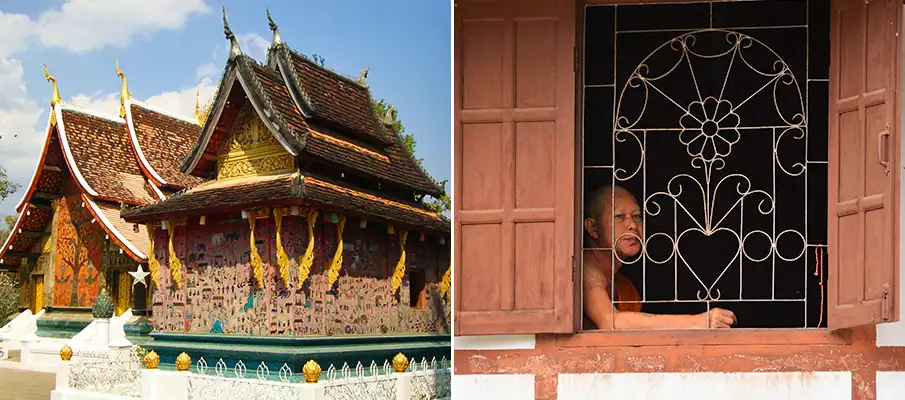
Food and Cuisine in Vientiane, What to Taste:
Food and cuisine in Vientiane reflect the rich flavors and culinary traditions of Laos. Exploring the local food scene is a delightful adventure that showcases the unique tastes and ingredients of the region. Here are some key points about food and cuisine in Vientiane:
-
- Sticky Rice: Sticky rice, known as „khao niao,“ is a staple in Lao cuisine and a fundamental part of every meal. It is typically eaten with various dishes, acting as a versatile accompaniment.
- Laap: Laap is a popular Lao dish made from minced meat (usually chicken, beef, or fish) combined with herbs, spices, lime juice, and ground toasted rice. It offers a refreshing blend of flavors and is often served with a side of fresh vegetables.
- Tam Mak Hoong: Tam Mak Hoong, or green papaya salad, is a spicy and tangy salad made with shredded green papaya, chili, garlic, lime juice, and fish sauce. It is a common dish in Vientiane and provides a burst of flavors.
- Mok Pa: Mok Pa is a flavorful Lao dish consisting of fish (usually catfish) marinated in a mixture of herbs, spices, and lemongrass. The fish is then wrapped in banana leaves and steamed, creating a fragrant and succulent dish.
- Khao Jee: Khao Jee is the Lao version of a baguette sandwich, reflecting the French colonial influence. It typically contains various fillings such as grilled meats, pâté, vegetables, and sauces, offering a delicious blend of flavors and textures.
- Street Food and Markets: Vientiane is renowned for its vibrant street food scene and bustling markets. The morning market (Talat Sao) and the night market along the Mekong River are popular spots to sample a wide array of local delicacies, snacks, and fresh produce.
- French-Inspired Pastries: Influenced by the French colonial era, Vientiane also offers a range of French-inspired pastries and baked goods. French-style bakeries and cafes in the city serve croissants, baguettes, and sweet treats that can be enjoyed alongside a cup of Lao coffee.
- Lao Beer and Beverages: Beerlao, the national beer of Laos, is widely available and enjoyed by locals and tourists alike. Additionally, Vientiane offers refreshing beverages such as fruit shakes, coconut water, and herbal teas, providing a respite from the tropical heat.
Vientiane’s food and cuisine showcase the unique flavors, influences, and culinary heritage of Laos. Exploring the city’s markets, street food stalls, and local eateries allows visitors to indulge in the vibrant tastes and textures that make Lao cuisine a delightful and memorable experience.
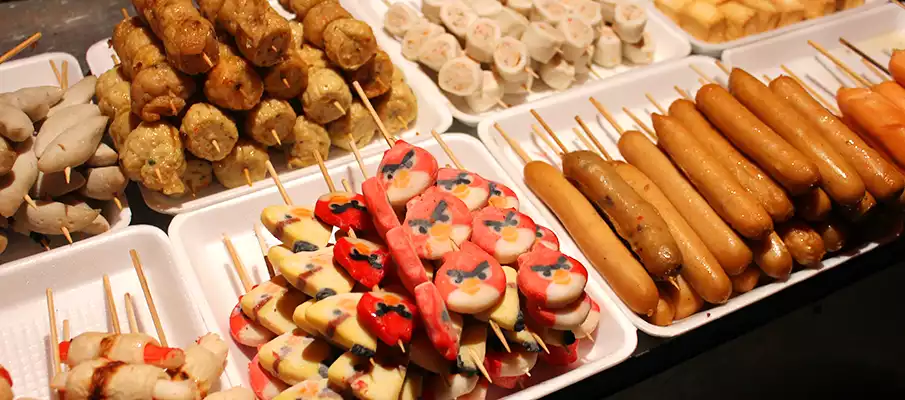
How to move and explore Vientiane?
Moving around and exploring Vientiane is relatively convenient and straightforward. Here are some ways to navigate the city and make the most of your exploration:
-
- Walking: Vientiane is a walkable city, especially in the central areas where many attractions are located. Take leisurely strolls along the riverside promenade or wander through the streets to discover hidden gems, temples, and local markets.
- Tuk-tuks: Tuk-tuks, three-wheeled motorized vehicles, are a popular mode of transportation in Vientiane. Negotiate the fare before hopping in and enjoy the breeze as you zip through the city. It’s advisable to agree on the price or use a ride-hailing app for a more reliable fare estimation.
- Bicycles: Renting a bicycle is a fantastic way to explore Vientiane at your own pace. Many guesthouses, hotels, and bike rental shops offer bicycles for a reasonable daily fee. You can effortlessly navigate the city, visit nearby attractions, and enjoy the scenic river views.
- Motorbike Rental: For those with experience riding motorbikes, renting one can provide greater mobility and flexibility. However, it’s crucial to be cautious and familiarize yourself with local traffic rules and road conditions before embarking on two-wheeled adventures.
- Taxis: Taxis are available in Vientiane, especially around major hotels and tourist areas. You can either hail a taxi on the street or arrange for one through your accommodation. Ensure the meter is used or negotiate a fare beforehand to avoid any misunderstandings.
- Songthaews: Songthaews are shared pick-up trucks or minivans that serve as a form of public transportation in Vientiane. They follow specific routes and can be flagged down along the street. These are an affordable option for getting around, but the routes might not cover all tourist destinations.
- Guided Tours: Joining guided tours can provide valuable insights into the city’s history, culture, and attractions. Many local tour operators offer guided excursions to key sites in and around Vientiane, making it easier to explore multiple places efficiently.
Remember to carry a map or use navigation apps on your phone to help you navigate the city. It’s also advisable to dress modestly, especially when visiting temples, and carry a bottle of water to stay hydrated while exploring Vientiane’s streets.

✈️ How to get and travel to Vientiane?
Getting to Vientiane, the capital city of Laos, is possible through various transportation options. Here’s a guide on how to travel to Vientiane:
-
- 1. By Air: The most convenient way to reach Vientiane is by flying into Wattay International Airport (VTE). It serves both domestic and international flights, connecting Vientiane to major cities in Southeast Asia and beyond. From the airport, you can easily take a taxi or arrange for transportation to your accommodation in the city.
- 2. By Land: If you are already in Laos or traveling from neighboring countries, you can consider entering Vientiane by land:
- From Thailand: Vientiane shares a border with Thailand. The most common entry point is the Thai-Lao Friendship Bridge connecting Nong Khai in Thailand to Vientiane. Buses, taxis, or tuk-tuks are available for transportation across the bridge.
- From Vietnam: If you are coming from Vietnam, you can travel to Vientiane by crossing the land border at the Lao Bao-Dansavanh checkpoint. From there, you can continue your journey by bus or private transportation.
- From other parts of Laos: Vientiane is well-connected to other cities and regions within Laos. Buses, minivans, and private taxis are popular options for traveling from destinations such as Luang Prabang, Vang Vieng, or Pakse to Vientiane. There is also a train by Lao-China Railway, check Laos Railway Map.
- 3. Visa Requirements: Before traveling to Vientiane, it’s important to check the visa requirements for your nationality. Laos offers visa-on-arrival for many nationalities at the airport and land borders, allowing you to obtain a visa upon arrival. However, it is advisable to confirm the visa regulations in advance and carry the necessary documents and fees.
-
- You can book tickets / flights to Vientiane in Laos on Baolau ➜ or 12go.asia ➜.

☀️ Weather in Vientiane + The Best Time to Visit:
The weather in Vientiane is characterized by a tropical monsoon climate, influenced by its location in Southeast Asia. The city experiences distinct seasons throughout the year, with variations in temperature and precipitation. Here’s an overview of the weather in Vientiane and the best time to visit:
-
- Dry Season (November to April): The dry season is considered the best time to visit Vientiane due to pleasant weather and minimal rainfall. From November to February, the temperatures are cooler, ranging from around 15°C (59°F) to 30°C (86°F), making it a popular time for tourism. From March to April, the temperatures rise, often exceeding 35°C (95°F), but it remains relatively dry.
- Wet Season (May to October): The wet season in Vientiane brings higher temperatures and increased rainfall. The months of May and June may experience occasional showers, while July to September are the wettest months, with frequent and heavy rainfalls. Temperatures during the wet season range from around 25°C (77°F) to 35°C (95°F), with high humidity.
The best time to visit Vientiane is during the dry season, particularly from November to February, when the weather is milder and more comfortable for outdoor activities and sightseeing. The months of December and January are particularly pleasant, with lower humidity and cooler temperatures.
| Month | Weather | Description |
|---|---|---|
| January | Cool and Dry | January in Vientiane offers cool temperatures and dry weather, making it an ideal time for exploring temples, visiting the vibrant markets, and enjoying outdoor activities. |
| February | Cool and Dry | February continues with cool temperatures and dry conditions, providing pleasant weather for sightseeing, enjoying riverfront walks, and sampling delicious Lao cuisine. |
| March | Warm and Dry | March brings warmer temperatures and dry weather to Vientiane, making it a great time to explore the city’s historical sites, experience traditional festivals, and enjoy outdoor dining along the Mekong River. |
| April | Hot and Dry | In April, Vientiane experiences hot temperatures and dry conditions. It is a great time to visit the city’s temples, take river cruises, and immerse in the local culture and arts scene. |
| May | Hot and Wet | May marks the beginning of the rainy season in Vientiane. While temperatures remain hot, occasional showers bring relief from the heat and create lush green landscapes, perfect for exploring gardens and parks. |
| June | Hot and Wet | June continues with hot and wet weather, with increased rainfall. It is a quieter month for tourism, offering opportunities to visit museums, discover local handicrafts, and engage in traditional workshops. |
| July | Hot and Wet | Similar to June, July remains hot and wet, with frequent afternoon showers. Despite the rain, there are still opportunities to explore historical sites, visit local markets, and experience traditional Lao performances. |
| August | Hot and Wet | August continues the hot and wet weather pattern, with regular rainfall. It is a great time to indulge in Lao cuisine, visit Buddhist temples, and participate in almsgiving ceremonies. |
| September | Hot and Wet | September in Vientiane is hot and wet, with intermittent showers. It is a quieter time for tourism,allowing visitors to explore the city’s historical and cultural attractions, visit art galleries, and experience the local way of life. |
| October | Cool and Dry | October brings cooler temperatures and drier weather to Vientiane, making it an excellent time for outdoor activities such as exploring the Buddha Park, cycling along the Mekong River, and enjoying sunset views. |
| November | Cool and Dry | November offers cool temperatures and dry conditions, making it an ideal month for visiting Vientiane’s temples, exploring the local markets, and savoring traditional Lao dishes. |
| December | Cool and Dry | December in Vientiane provides cool temperatures and dry weather, making it a delightful time to stroll along the riverfront promenade, visit the That Luang stupa, and immerse in the festive atmosphere of the Lao National Day celebrations. |
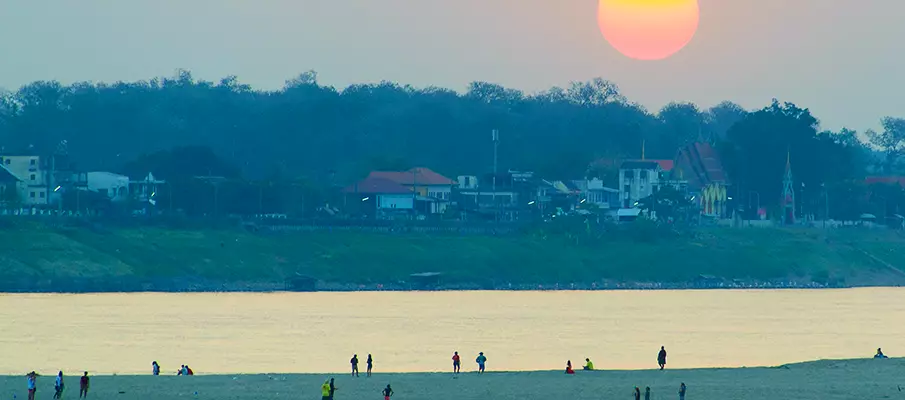
🏡 Accommodation in Vientiane / Where to Stay:
Vientiane, the capital city of Laos, offers a range of accommodation options to suit different budgets and preferences. Here’s an overview of the types of accommodations you can find in Vientiane:
-
- Hotels: Vientiane has a variety of hotels ranging from budget to luxury options. In the city center and along the Mekong River, you’ll find upscale hotels with modern amenities, rooftop pools, spas, and panoramic views. There are also mid-range and budget hotels that provide comfortable rooms and essential facilities.
- Guesthouses: Guesthouses are a popular choice for budget travelers and backpackers. These accommodations offer simple, affordable rooms with basic amenities such as private or shared bathrooms. Guesthouses are often family-run, providing a friendly and cozy atmosphere for guests.
- Boutique Hotels: Vientiane is home to several boutique hotels that offer a unique and personalized experience. These smaller establishments often have stylish designs, personalized service, and a distinct charm. They cater to travelers looking for an intimate and boutique setting.
- Guest Suites and Homestays: For a more authentic and immersive experience, consider staying in a guest suite or homestay. These options allow you to stay with local families or in private residences, providing an opportunity to experience Lao culture firsthand and interact with the locals.
- Hostels: Vientiane also offers a few hostels that cater to budget travelers and backpackers. Hostels provide dormitory-style accommodations with shared facilities, making them a social and affordable option. They often have communal spaces, bars, and organized activities, creating a vibrant atmosphere for meeting fellow travelers.
- Luxury Resorts: Just outside the city, along the Mekong River or in the surrounding countryside, you’ll find luxury resorts that offer a tranquil and upscale experience. These resorts boast luxurious amenities, spas, swimming pools, and stunning views, providing a perfect retreat from the bustling city.
➜ Accommodation in Vientiane – Book Here
🔍 Interesting Places + Activities in Vientiane:
-
- Pha That Luang: This iconic golden Buddhist stupa is a symbol of both Buddhism and Laos‘ national identity. Explore its magnificent architecture, stroll through the surrounding grounds, and soak in the spiritual ambiance.
-
- Wat Si Saket: Known for its thousands of Buddha statues, Wat Si Saket is the oldest temple in Vientiane. Admire the intricate wall paintings, explore the serene courtyard, and gain insights into Lao Buddhist traditions.
-
- Wat Si Muang: What makes Wat Si Muang particularly unique is its cultural and spiritual significance to the local community. According to local folklore, the temple was built on the spot where a young woman named Si Muang sacrificed herself during the construction of a nearby bridge. Her sacrifice was believed to appease the spirits and protect the city.
-
- Patuxai: Also known as the Victory Monument, Patuxai is a prominent landmark inspired by the Arc de Triomphe in Paris. Climb to the top for panoramic views of Vientiane and its surroundings.
-
- Ho Phrakeo Museum: It is a former temple that has been transformed into a museum, showcasing an impressive collection of Buddhist art and artifacts. The temple was originally constructed in the 16th century as a royal temple, built to house the Emerald Buddha, which is a highly revered and culturally significant image of Buddha.
-
- Buddha Park (Xieng Khuan): Located on the outskirts of Vientiane, Buddha Park is a captivating sculpture park filled with statues inspired by Hindu and Buddhist mythology. Wander among the impressive statues and learn about their symbolic meanings.
-
- That Dam: Known as the „Black Stupa,“ That Dam is a mysterious monument shrouded in legends and folklore. Enjoy the peaceful atmosphere and learn about the intriguing stories surrounding this ancient structure.
-
- Morning Market (Talat Sao): Dive into the vibrant atmosphere of the Morning Market, where you can explore an array of stalls selling textiles, handicrafts, souvenirs, and local products. Bargain for unique finds and immerse yourself in the local shopping culture.
-
- Vientiane Night Market: The Vientiane Night Market, also known as the Vientiane Evening Market, is a popular and vibrant market located in the capital city of Laos, Vientiane. This nightly market takes place along the scenic Mekong River promenade and is a major attraction for both tourists and locals.
-
- Riverside Promenade: Take a leisurely stroll along the Mekong River’s scenic riverside promenade. Enjoy picturesque views, relax at riverside cafes, and witness the beautiful sunset over the water.
-
- Lao National Museum: Gain insights into Laos‘ history, culture, and heritage at the Lao National Museum. Explore the exhibits, artifacts, and displays that depict the country’s past and present.
-
- Traditional Lao Massage: Treat yourself to a traditional Lao massage and experience the healing techniques and relaxation methods of the local culture. Unwind and rejuvenate your body and mind.
-
- Culinary Exploration: Indulge in the flavors of Lao cuisine by sampling local dishes at markets, street food stalls, and traditional restaurants. Try classics like laap, tam mak hoong, and sticky rice, and immerse yourself in the vibrant food culture of Vientiane.
-
- COPE Visitor Centre: Learn about the inspiring work of COPE (Cooperative Orthotic and Prosthetic Enterprise) in assisting people affected by unexploded ordnance. The center showcases the impact of UXOs in Laos and provides insights into the ongoing efforts to support those in need.
-
- Talat Sao Mall: Experience modern shopping at Talat Sao Mall, a bustling commercial center in Vientiane. Browse through a variety of shops selling clothing, accessories, electronics, and local products. It’s a great place to find souvenirs or enjoy a meal at one of the many eateries.
-
- Wat Ong Teu Mahawihan: Discover the exquisite beauty of Wat Ong Teu Mahawihan, a temple known for its stunning wooden carving work. Admire the intricate details and serene atmosphere of this unique temple.
-
- Lao Textile Museum: Immerse yourself in the world of traditional Lao textiles at the Lao Textile Museum. Explore exhibits showcasing the art of weaving, dyeing techniques, and the cultural significance of textiles in Lao society.
-
- National Ethnic Cultural Park: Located outside the city center, the National Ethnic Cultural Park offers a glimpse into the diverse ethnic groups of Laos. Explore traditional houses, exhibits, and performances representing different ethnic cultures, providing a deeper understanding of the country’s rich cultural tapestry.
📍 Vientiane in Laos – Google Map:
❓ Frequently Asked Questions + Tips for Vientiane:
1. How to book and buy tickets or flight to Vientiane?
2. What are the must-visit attractions in Vientiane?
-
- Vientiane is home to several notable attractions, including the iconic Pha That Luang, the sacred Wat Sisaket, the serene Buddha Park (Xieng Khuan), and the beautiful Patuxai Victory Monument. Don’t miss exploring the vibrant night market and taking a stroll along the Mekong Riverfront.
3. What is the best time to visit Vientiane?
-
- The best time to visit Vientiane is during the dry season, which typically runs from November to April. The weather is pleasant, with lower humidity and less rainfall, making it ideal for exploring the city’s attractions and enjoying outdoor activities.
4. Are there any cultural festivals or events in Vientiane?
-
- Vientiane hosts several cultural festivals throughout the year. One of the most significant is Boun That Luang, which takes place in November and celebrates the famous golden stupa, Pha That Luang. The Lao New Year, known as Boun Pi Mai, is also a vibrant celebration with water fights and traditional ceremonies in April.
5. What are some unique dishes to try in Vientiane?
-
- Vientiane offers a delicious culinary scene. Don’t miss trying local specialties like tam mak hoong (spicy green papaya salad), laap (minced meat salad), khao piak sen (Lao-style noodle soup), and ping gai (grilled chicken skewers). For a unique dining experience, visit the famous local food stalls and night markets.
6. Are there any day trips or excursions from Vientiane?
-
- Yes, there are several day trips and excursions you can take from Vientiane. Visit the Buddha Park (Xieng Khuan), located just outside the city, to see a collection of fascinating and intricate Buddhist and Hindu sculptures. You can also explore the nearby Nam Ngum Reservoir or take a boat trip along the Mekong River to explore the surrounding countryside.
7. Are there any historical sites to visit in Vientiane?
-
- Vientiane has a rich history, and you can explore its historical sites. Visit the serene Wat Sisaket, which is the oldest temple in Vientiane and houses thousands of Buddha images. The nearby Haw Phra Kaew, once the royal temple, now serves as a museum showcasing Buddhist art and artifacts.
8. Can I visit the COPE Visitor Centre in Vientiane?
-
- Yes, the COPE Visitor Centre is an important attraction in Vientiane. It is a museum and educational center that highlights the impact of unexploded ordnance (UXO) in Laos. The center provides valuable insights into the country’s history and the ongoing efforts to clear UXOs.
9. Is it possible to rent a bicycle in Vientiane?
-
- Yes, renting a bicycle is a popular way to explore Vientiane. Many rental shops offer bicycles for a day or longer, allowing you to navigate the city at your own pace and discover hidden gems. It’s a great way to experience the local lifestyle and visit attractions beyond the city center.
10. What are some shopping options in Vientiane?
-
- Vientiane offers various shopping opportunities. Visit the bustling Morning Market (Talat Sao) for a wide range of goods, including textiles, handicrafts, and souvenirs. The Night Market along the Mekong Riverfront is perfect for browsing local handicrafts, clothing, accessories, and enjoying street food.
11. Is it possible to visit the nearby Buddha Park (Xieng Khuan) from Vientiane?
-
- Yes, it is possible to visit the Buddha Park (Xieng Khuan) from Vientiane. The park is located about 25 kilometers outside the city and is easily accessible by car, tuk-tuk, or organized tour. The park is known for its unique and intricate sculptures of Buddhist and Hindu deities, making it a fascinating and photogenic attraction to explore.
12. Where you can travel from Vientiane?
-
- From Vientiane you can travel by train, bus or plane to Luang Prabang, Vang Vieng, or you can cross the border via Thai-Lao Friendship Bridge and go to Bangkok – the capital of Thailand.
13. What is the weather and climate in Laos?
-
- Weather in Laos varies between distinct wet and dry seasons. The wet season, prevailing from May to October, brings heavy rainfall and heightened humidity, contributing to lush landscapes and abundant rivers. In contrast, the dry season, spanning from November to April, features lower humidity and cooler temperatures, making it an ideal time for travel with clear skies and enjoyable outdoor activities.
BOOK a TOUR / TRIP in Vientiane ➜
| Interesting Facts about Vientiane, Laos: | Description |
|---|---|
| 1. The Most Relaxed Capital | Vientiane is often considered one of the most laid-back capital cities in the world. With its slow pace of life, quiet streets, and a population of just over 200,000, Vientiane offers a stark contrast to the bustling metropolises found in many other Asian countries. Visitors often appreciate the relaxed atmosphere, which allows for a leisurely exploration of the city and a break from the usual urban hustle and bustle. |
| 2. That Luang Stupa | The golden That Luang Stupa is the national symbol of Laos and one of the most important religious monuments in the country. It’s a grand and glistening sight, covered in gold leaf. The stupa represents Lao Buddhism and Lao sovereignty and is a sacred site for pilgrims. It stands as a symbol of national pride and unity and is particularly impressive when the sun’s rays hit it, creating a radiant spectacle. Visitors can explore the stupa’s serene grounds and learn about its historical and spiritual significance. |
| 3. French Colonial Legacy | Vientiane, like the rest of Laos, was once a French colony, and the legacy of French colonialism is evident in the city’s architecture and cuisine. French-inspired architecture can be seen in buildings like the Presidential Palace and the Patuxai Victory Monument, which resembles the Arc de Triomphe. The fusion of Lao and French cuisines is also a delight for food lovers. Vientiane is home to numerous bakeries and cafes offering freshly baked baguettes and French pastries, and you can savor a strong cup of Lao coffee, often prepared with a French press. This blend of cultures gives Vientiane a unique and charming character. |
| 4. Patuxai Victory Monument | The Patuxai Victory Monument, often referred to as the „Vertical Runway,“ is a remarkable architectural landmark in Vientiane. It was built in the 1960s and is dedicated to those who fought for independence from foreign rule. The monument is notable for its impressive design, featuring intricate sculptures and artistic motifs. Visitors can climb to the top for panoramic views of the city. While it may resemble the Arc de Triomphe in Paris, the monument has a unique Lao touch, with depictions of the mythological Hindu deity Naga. It’s a symbol of Laotian patriotism and a popular spot for both tourists and locals. |
| 5. Pha That Luang Festival | The Pha That Luang Festival is one of the most important annual events in Vientiane. It celebrates the grandeur of the That Luang Stupa and is held during the full moon of the twelfth lunar month. The festival features religious ceremonies, processions, and traditional music and dance performances. It’s a time when people from all over Laos and neighboring countries gather to pay their respects and partake in the festive atmosphere. During the festival, the That Luang Stupa is adorned with vibrant decorations and illuminated, creating a dazzling sight. The event is an opportunity for visitors to witness the spiritual and cultural significance of Vientiane’s most iconic monument. |
| 6. Buddha Park (Xieng Khuan) | Located just outside Vientiane, the Buddha Park, or Xieng Khuan, is a unique and captivating site. The park is home to over 200 statues depicting a combination of Hindu and Buddhist deities and mythical creatures. These sculptures are the work of the visionary artist and mystic Luang Pu Bunleua Sulilat. The most iconic statue in the park is a giant reclining Buddha, and visitors can enter the structures to explore their interiors, which are adorned with intricate carvings. The Buddha Park is a surreal and spiritual place, offering insight into the fusion of religious beliefs in the region. |
| 7. The Morning Market (Talat Sao) | Vientiane’s Morning Market, or Talat Sao, is a bustling and vibrant place to explore local culture and purchase souvenirs. The market is open throughout the day, but it’s particularly lively in the morning. It offers a wide range of products, from clothing and textiles to jewelry, electronics, and local handicrafts. Visitors can practice their bargaining skills while immersing in the daily life of Vientiane. It’s an excellent spot to find traditional Lao silk, woven textiles, and handcrafted items that make for meaningful keepsakes. |
| 8. Lao National Museum | The Lao National Museum, also known as the Lao Revolutionary Museum, provides a comprehensive insight into Laos‘ history and culture. The museum’s exhibits cover the ancient civilizations that once thrived in the region, the colonial period, the struggle for independence, and the modern era. While the museum’s exhibits may be somewhat outdated, they offer valuable context and information for visitors interested in understanding the country’s complex past. It’s an opportunity to learn about Laos‘ path to independence and its political and cultural evolution. |
| 9. Wat Sisaket | Wat Sisaket is one of the most revered temples in Vientiane and a testament to the city’s rich Buddhist heritage. Unlike many other temples in Laos, Wat Sisaket survived the Siamese invasion of 1828, making it one of the oldest and most intact temples in Vientiane. The temple features a cloister containing thousands of Buddha images, each unique and meticulously crafted. The architecture and artistry of Wat Sisaket provide an opportunity for visitors to delve into the spiritual and cultural aspects of Vientiane. The temple’s serene atmosphere and exquisite religious art make it a must-visit site for those interested in Lao Buddhism. |
| 10. Lao Cuisine | Vientiane is a paradise for food lovers, offering a diverse array of Lao cuisine. Local specialties include laap, a minced meat salad with fresh herbs, and tam mak hoong, a spicy green papaya salad. Sticky rice is a staple, and it’s typically served in bamboo containers. The city is also known for its French-inspired bakeries, where you can enjoy delicious baguettes and pastries. Vientiane’s street food scene is vibrant, and you can sample grilled meats, noodles, and local snacks. The city’s culinary diversity reflects the multicultural influences that have shaped Vientiane, making it a destination for a culinary adventure. |


Luang Prabang in Laos|Kampot in Cambodia|Sihanoukville in Cambodia|Phnom Penh in Cambodia|Siem Reap in Cambodia|Saigon in Vietnam
